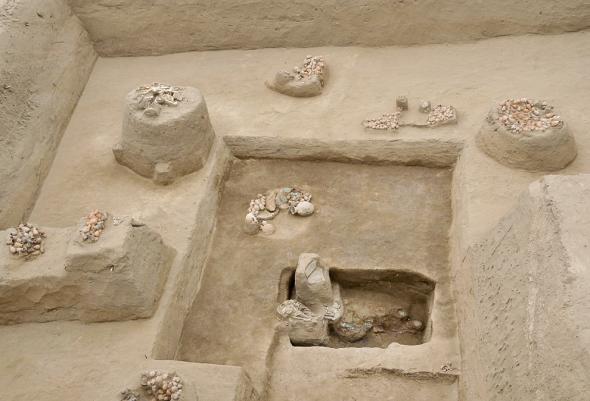Ker Than for National Geographic News (Published July 28, 2011).
Pre-Inca burial found near temple of human sacrifice.

PHOTOGRAPH COURTESY CARLOS WESTER LA TORRE
With ancient ceremonial knives at his side, an elite 14th-century executioner—a key player in human-sacrifice rituals—has been uncovered in a tomb at a pre-Inca site in Peru, archaeologists suggest.
The tomb was found at Chotuna-Chornancap, a coastal site near the Peruvian city of Chiclayo (map). The site was once an important ceremonial center of the Lambayeque culture, also known as the Sicán.
The culture lived along the northern coasts of Peru from around A.D. 800 until around 1375, when the neighboring Chimú civilization conquered the Sicán.
Previous excavations at Chotuna-Chornancap by Peruvian archaeologist Carlos Wester La Torre, who led the team that found the purported sacrificer, revealed a temple containing the remains of several women who were mutilated as part of human-sacrifice rituals.
Wester and other Peruvian archaeologists have suggested that the rulers of Chotuna-Chornancap may have claimed to be the descendants of Naylamp, a god-like figure from the sea that legend says founded the Sicán culture.
Copper-Skirted Sacrificer
The new tomb discovery was made during excavations of a section of Chotuna-Chornancap that was used to perform crop-fertility rituals, according to the team.
The skeleton belonged to a male between 20 and 30 years old, and that the tomb was built sometime in the late 1200s or early 1300s A.D., toward the end of the Sicán period, they say.
The cause of death of the tomb’s inhabitant is unknown, but based on the kind and quantity of artifacts buried with him—including ceramic pots, a skirt made of copper disks, and ornate copper knives—the team thinks he was a member of the Sicán elite and possibly performed ritual human offerings by order of a priest.
Wester speculated that a sacrificer was more than just a simple executioner. He would have been entrusted with other responsibilities related to the ceremonies surrounding the sacrifices, the archaeologist added.
Ceramic and metal objects were also found near the tomb—possibly left as offerings to the dead sacrificer, or they may be evidence of another tomb, said Wester, director of the Brüning National Archaeological Museum in the city of Lambayeque.
Or Is a Knife Just a Knife?
Archaeologist and Sicán expert Izumi Shimada said the new tomb could shed light on what the Sicán culture was like just prior to its collapse.
Previous studies, including Shimada’s own work, have focused largely on the Sicán-Classic, or middle-Sicán, period, which lasted from A.D. 900 to 1100.
Wester’s work “fills a large void that we have,” said Shimada, of Southern Illinois University, who was not involved in the new discovery.
But Shimada said it’s still too early conclude that the person buried in the tomb played a role in Sicán human sacrifices.
Knives made from precious metals such as copper or even gold were status symbols for the Sicán elite, Shimada said. It was typical for members of the upper class to be buried with such blades.
“The presence of such a knife alone does not provide enough basis to say the person was a priest or that they performed sacrifices,” Shimada said.
“Unless the knife were analyzed and contained DNA or blood samples, you cannot really make that kind of logical connection.”









